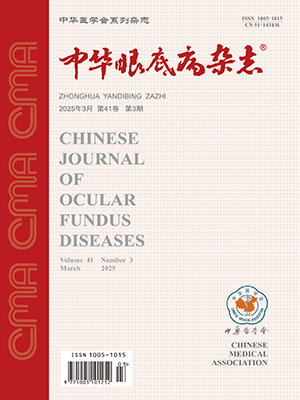Objective To investigate the characteristics of fundus photography and fundus fluorescein angiography (FFA) of IRVAN (idiopathic retinal vasculitis, aneurysms, and neuroretinitis) syndrome and Eales disease. Methods The fundus photography and FFA data of 4 cases (8 eyes) with IRVAN syndrome and 43 cases (68 eyes) with Eales disease were retrospectively analyzed. All patients received ophthalmic routine examinations, including visual acuity, intraocular pressure, slit-lamp microscope and indirect ophthalmoscope. All patients had taken fundus photography and FFA for both eyes, except 4 patients of Eales disease who had vitreous hemorrhage in one eye. All 4 cases(1 male/3 female )with IRVAN syndrome were bilateral and aged 1643 years old( mean age 2700 plusmn;1293 years old). 43 cases (32 male/11 female) of Eales disease aged 6-59 years old( mean 30.79 plusmn;11.46 years old), 29 cases were bilateral and 14 cases were unilateral. Both diseases had retinal vascular whitesheath or white threadlike changes, exudative retinal hemorrhage and vitreous hemorrhage. Results Both arteries and veins of posterior pole of all eyes with IRVAN syndrome were involved and shown multiple retinal macroaneurysms. Other signs of IRVAN syndrome included capillary occlusion and nonperfusion (7/8 eyes, 87.5%),fluorescein leakage and edema of optic disc (5/8 eyes,62.5%), optic atrophy(2/8 eyes,25%), vitreous hemorrhage(1/8 eyes,12.5%), neovascularization of optic disc(2/8 eyes,25%), retinal neovascularization(4/8 eyes,50%) and macular edema(4/8 eyes,50%). The signs of Eales disease included fluorescein leakage of peripheral retinal vein (68/68 eyes, 100%), fluorescein leakage of posterior retinal vein (32/68 eyes, 47.06%), artery involvement (5/68 eyes, 7.35%), peripheral capillary occlusion and nonperfusion (38/68 eyes, 55.88%), fluorescein leakage of optic disc(29/68 eyes, 42.65%), neovascularization of optic disc(4/68 eyes,5.88%), retinal neovascularization(26/68 eyes,38.2%) and macular edema(15/68 eyes,22.06%). Compared IRVAN syndrome with Eales disease, the difference of artery inflammation, vein inflammation, retinal macroaneurysms in posterior area had statistics significance(all P=000,P lt;005), and that of edema of optic disc, retinal vascular nonperfusion area, neovascularization of optic disc, neovascularization elsewhere, and macular edema had no statistics significance( chi;2=0.479,P>0.05;P=0.131,P>0.05; chi;2=1.449,P>0.05; chi;2=0.068,P>0.05; chi;2=1.676,P>0.05). Conclusions Both IRVAN syndrome and Eales disease may have vein and artery inflammation in posterior pole of the eye, and may result in neuroretinitis. IRVAN syndrome has much more vein and artery inflammation in posterior pole than Eales disease. Posterior retinal macroaneurysms is the most important sign for the diagnosis and differential diagnosis of IRVAN syndrome and Eales disease.
Citation: SHI XueHui Wenbin Wei Lihong Yang Wang Guangli Bei Tian Ning Ding Dan Zhou Shaohua Wang. Comparative analysis of the characteristics of fundus fluorescein angiography of IRVAN syndrome and Eales disease. Chinese Journal of Ocular Fundus Diseases, 2009, 25(2): 119-123. doi: Copy
Copyright © the editorial department of Chinese Journal of Ocular Fundus Diseases of West China Medical Publisher. All rights reserved




